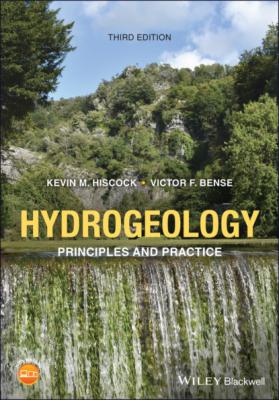ТОП просматриваемых книг сайта:
Hydrogeology. Kevin M. Hiscock
Читать онлайн.Название Hydrogeology
Год выпуска 0
isbn 9781119569510
Автор произведения Kevin M. Hiscock
Жанр Биология
Издательство John Wiley & Sons Limited
1.7.2.1 European Union Water Framework Directive
The Water Framework Directive (WFD) establishing a framework for Community action in the field of water policy is a far‐reaching piece of legislation governing water resources management and protection in the European Union (Council of the European Communities 2000). The Directive (2000/60/EC) was adopted in December 2000 and requires Member States to enforce appropriate measures to achieve good ecological and chemical status of all water bodies with a review of progress based on a six‐year cycle. The purpose of the Directive is to establish a framework for the protection of inland surface waters, transitional waters (estuaries), coastal waters and groundwater to prevent further deterioration of aquatic ecosystems and, with regard to their water needs, terrestrial ecosystems and wetlands. In its implementation, the WFD requires an integrated approach to river basin management and promotes sustainable water use based on long‐term protection of available water resources. A specific purpose of the WFD is to ensure the progressive reduction of pollution of groundwater and prevent its further pollution.
Article 17 of the WFD required a proposal (2003/0210(COD)) from the Commission for a Groundwater Daughter Directive leading to the adoption of specific measures to prevent and control groundwater pollution and achieve good groundwater chemical status (Commission of the European Communities 2003). In addition, the proposal introduced measures for protecting groundwater from indirect pollution (discharges of pollutants into groundwater after percolation through the ground or subsoil). In the Groundwater Directive (Council of the European Union 2006), compliance with good chemical status is based on a comparison of monitoring data with quality standards existing in EU legislation on nitrates and plant protection and biocidal products which set threshold values (maximum permissible concentrations) in groundwater for a number of pollutants. With regard to pollutants that are not covered by EU legislation, the Directive (2006/118/EC) requires Member States to establish threshold values defined at the national, river basin or groundwater body levels, thus taking into account the great diversity of groundwater characteristics across the EU.
The Groundwater Directive sets out specific criteria for the identification of significant and sustained upward trends in pollutant concentrations, and for the definition of starting points for when action must be taken to reverse these trends. In this respect, significance is defined both on the basis of time series and environmental significance. Time series are periods of time during which a trend is detected through regular monitoring. Environmental significance describes the point at which the concentration of a pollutant starts to threaten to worsen the quality of groundwater. This point is set at 75% of the quality standard or the threshold value defined by Member States. Under the WFD, a comprehensive programme of measures to prevent or limit pollution of water, including groundwater, became operational. Monitoring results obtained through the application of the Groundwater Directive are used to design the measures to prevent or limit pollution of groundwater.
1.7.3 Groundwater abstraction in North America
A similar picture emerges of the importance of groundwater for the population of North America. In Canada, almost nine million people, or 30% of the population, rely on groundwater for domestic use (Government of Canada 2021). Approximately two‐thirds of these users live in rural areas where groundwater is a reliable and cheap water supply that can be conveniently abstracted close to the point of use. The remaining groundwater users are located primarily in smaller municipalities where groundwater provides the primary source for their water supply systems. For example, 100% of the population of Prince Edward Island and over 60% of the population of New Brunswick rely on groundwater for domestic supplies. In Ontario, a province where groundwater is also used predominantly for supplying municipalities, 29% of the population is reliant on groundwater. Furthermore, the predominant use of groundwater varies by province. In Ontario, Prince Edward Island, New Brunswick and the Yukon, the largest users of groundwater are municipalities;

